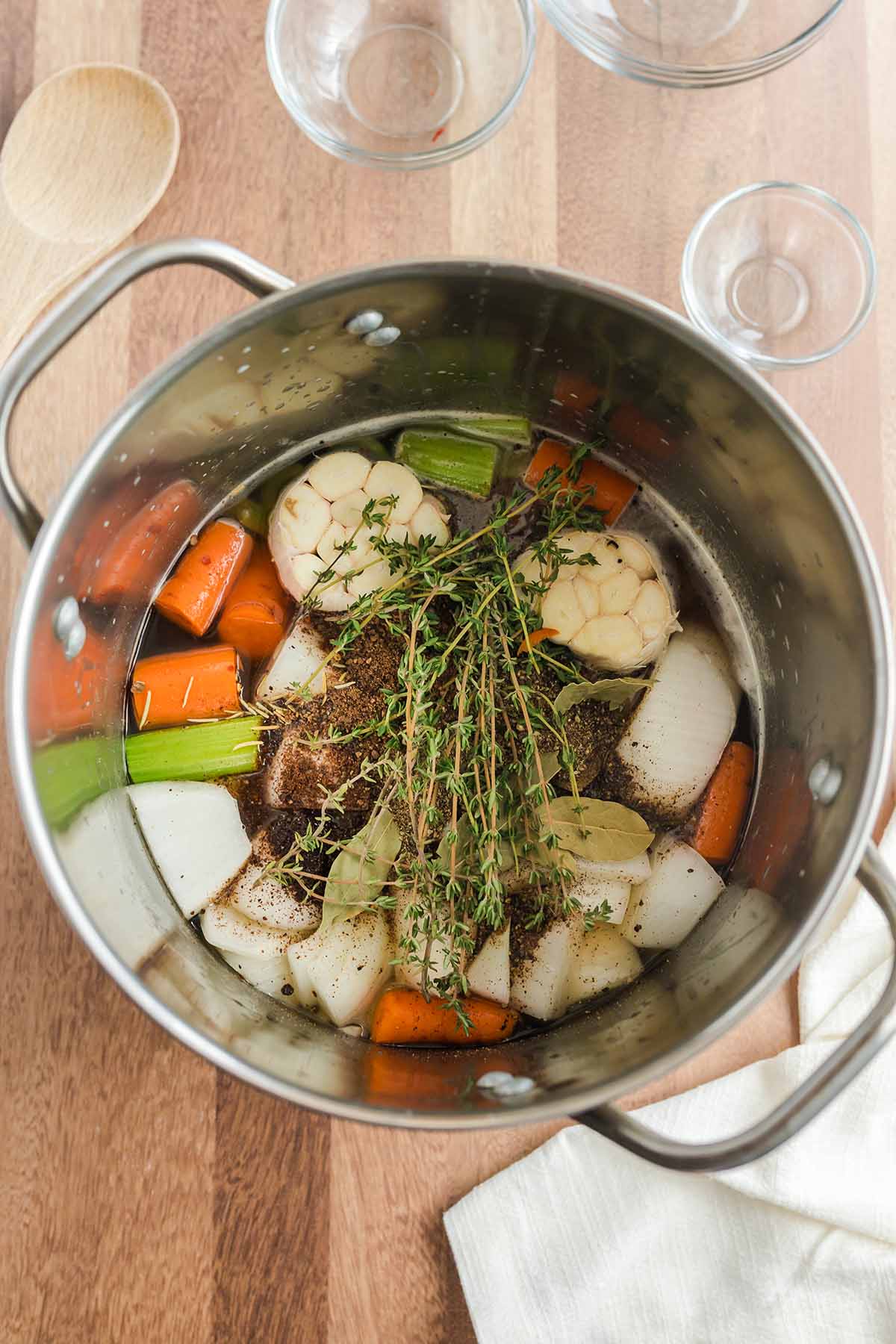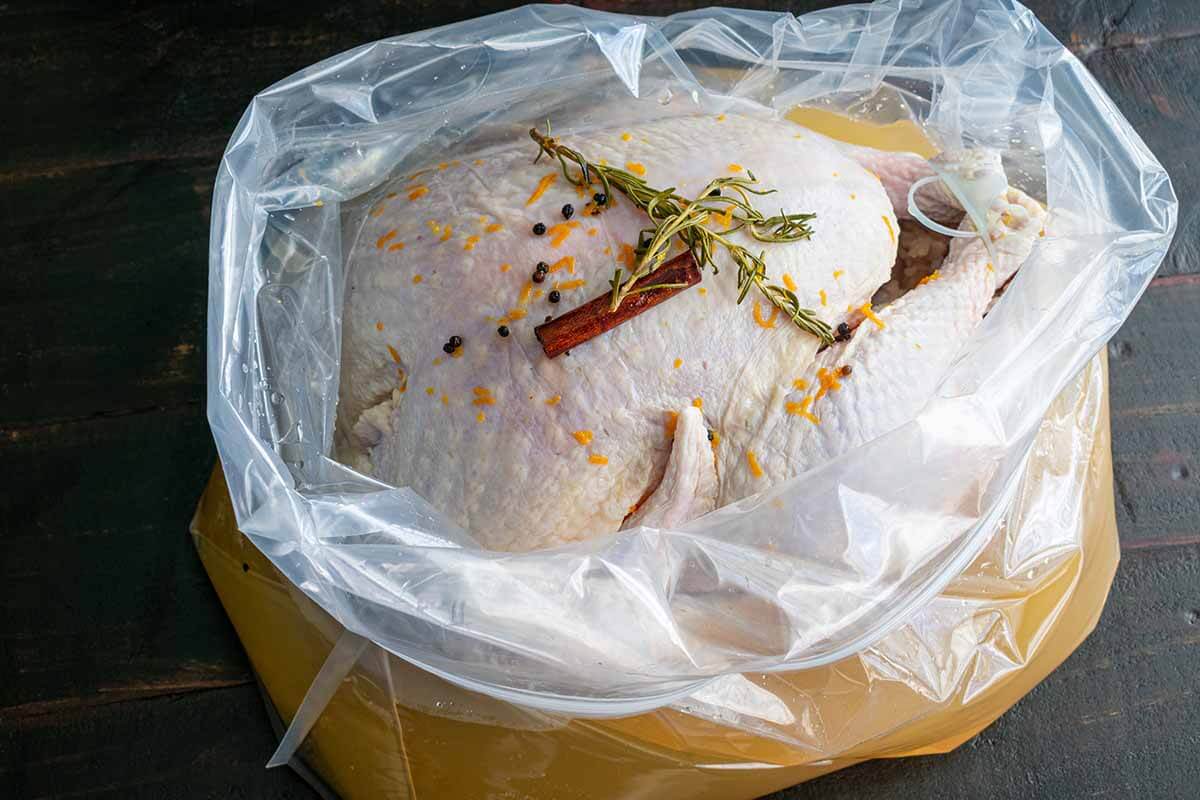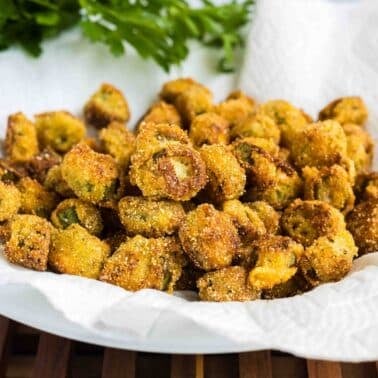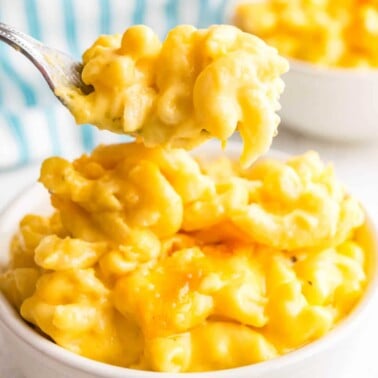We’ve got you covered with everything you need to know about brining a turkey! Elevate your holiday meal with a juicy, flavorful bird. This comprehensive guide covers everything from the basics of brining to advanced techniques.

Table of contents
- What is a turkey brine?
- Why brine a turkey?
- What is wet brine?
- What is dry brine?
- What do you brine a turkey in?
- How long to brine?
- Do you rinse a brined turkey?
- Why use a bag for turkey brine?
- Can I cook the turkey in the brining bag?
- Can you brine a frozen turkey?
- Can you brine a Butterball?
- Can you over-brine?
- Can you brine and inject?
- Does a brined turkey cook faster?
What is a turkey brine?
It’s a saltwater solution that infuses your bird with moisture and flavor. Herbs, spices, and sometimes sugar are added for extra flair.
The Best Turkey Brine Recipe – our flavorful and easy brine recipe will help you cook the best turkey ever!
Why brine a turkey?
Brining isn’t just a culinary trend; it’s backed by science. Research published in the Journal of Food Science indicates that the salt in the brine dissolves muscle fibers. This process:
- Ensures the meat retains more moisture
- Results in a juicier, more succulent bird
- Enhances the infusion of herbs and spices
So, if you’re looking for that perfect combination of juicy, flavorful, and tender, brining is the way to go.
What is wet brine?
Wet brining is the traditional method of submerging the turkey in a liquid solution of salt, water, and often other flavoring agents like herbs and spices.
Key Features
Moisture Lock: The liquid helps the bird to absorb moisture, making it juicier.
Flavor Infusion: Herbs, spices, and aromatics in the brine can be easily absorbed.
Time-Consuming: Usually requires at least 8-24 hours to be effective.
Wet brining is perfect for those who want a juicy, succulent turkey with the opportunity for complex flavor profiles.
What is dry brine?
Dry brining involves rubbing salt and other seasonings directly onto the turkey’s skin and meat. Unlike wet brining, no additional liquid is used.
Key Features
Easier Storage: No need for a large container to hold liquid.
Crispier Skin: The absence of extra liquid results in crispier skin after roasting.
Shorter Time: While letting sit for several hours is still beneficial, dry brining often requires less time than wet brining.
If you’re short on space or prefer a bird with crisper skin, dry brining could be the right choice.
Both methods have pros and cons, so your choice between wet and dry brine will depend on your specific needs and flavor goals.
Here at Southern Food and Fun, we prefer the wet brining method. It has been working well for us for many years, and if it ain’t broke, don’t fix it!
Our thoughts on wet vs. dry brining
Here at Southern Food and Fun, we prefer the wet brining method. It has been working well for us for many years and if it ain’t broke, don’t fix it!
Here’s our favorite method for cooking that bird: How to Roast a Perfect Turkey
What do you brine a turkey in?
Choosing the correct container is crucial for a successful brining experience. Each option has its pros and cons:
Brining bags: Convenient and great for limited space as well as containing the liquid.
Food-grade plastic buckets: Good for large birds as long as you have room in the fridge.
Stainless steel pots: Sturdy but take up a lot of space and heavier.
Cooler: Ideal for when fridge space is tight, just add lots of ice!
Cambro: A professional-grade, durable choice that you can use for many things.
Cooler Method With a Twist
If you opt for a cooler, make sure the turkey and the brining solution are chilled, maintaining a temperature no higher than 40°F. Place the turkey in a brining bag filled with the brine, then into the cooler.

Pro tip
Use a thermometer with an alarm to notify you if the temperature rises or falls out of the safe range. Once you’ve set up your cooler and thermometer, it’s crucial not to open the cooler, keeping the internal environment stable.
Choosing the correct container is an essential first step in your brining journey, and knowing how to adapt each one to your needs will make the process even smoother.
Tools to help with brining
Description goes here
How long to brine?
A good rule of thumb is one hour per pound. However, soaking it for up to 24 hours maximizes flavor and tenderness.
Do you rinse a brined turkey?
Yes, rinsing is important to remove excess salt, but it comes with safety considerations. Here’s how to do it right:
Why Rinse?
Rinsing helps remove excess salt and brine ingredients, ensuring your bird isn’t overly salty. However, doing this the wrong way could risk cross-contamination in your kitchen.
How to Rinse Safely
Use a Clean Sink: Make sure your sink is sanitized before placing the turkey in it.
Cold Water: Use cold water to rinse the turkey thoroughly.
Low Pressure: Avoid high water pressure, as it can splatter, spreading bacteria around your sink area.
Containment: Consider rinsing inside a large bowl or basin within the sink to contain any splatter.
Kitchen Cleanliness
Immediate Cleanup: Right after rinsing, clean and sanitize your sink and any nearby surfaces that could be contaminated.
Use Separate Utensils: Keep utensils and dishes used for rinsing away from other cooking tools.
Hand Washing: Wash your hands thoroughly with soap and water before and after handling the turkey.
Rinsing a brined turkey is an essential step, but it’s crucial to do it safely to prevent cross-contamination and ensure a delicious and safe holiday feast.
Why use a bag for turkey brine?
Using a brining bag offers several advantages that can make your brining process smoother and more effective. Here’s why you might want to consider this method:
Benefits of Using a Bag
Less Mess: A bag contains the brining solution more effectively, minimizing leaks and spills.
Space-Saving: Bags take up less room in your fridge or cooler than rigid containers.
Even Coverage: The flexible material ensures the brining solution is distributed evenly around the bird.
How to Choose a Bag
Durability: Look for heavy-duty bags that won’t easily tear.
Size: Make sure the bag is large enough to hold your bird and enough brining solution to submerge it.
Sealable: Opt for bags with a reliable sealing mechanism to prevent leaks.
Tips for using a brining bag
Double-Bagging: For added security against leaks, you can place one bag inside another.
Removing Air: Try to remove as much air as possible before sealing the bag. This ensures that the solution covers the bird uniformly.
Rotation: While not strictly necessary due to the bag’s flexibility, rotating the bag occasionally can help redistribute the brining solution.
Using a brining bag allows you to set yourself up for a more convenient and effective brining process.
Can I cook the turkey in the brining bag?
While brining bags are excellent for marinating, they’re not designed to withstand high cooking temperatures. Most brining bags are made of plastic materials that can melt or release harmful substances when exposed to heat. Here’s what you should do instead:
Transfer to Roasting Pan: Once your turkey has soaked up all the brining goodness, transfer it to a roasting pan for cooking.
Rinse and Pat Dry: Remember to rinse the excess salt and pat the turkey dry before it goes into the oven.
Disposable Roasting Bags: If you like the idea of a bag for cooking, there are oven-safe roasting bags specifically designed for that purpose.
So, while it might seem convenient to go from brining to baking in one fell swoop, switching containers is essential to ensure both safety and delicious results.
Pin this now to save it for laterCan you brine a frozen turkey?
Brining a frozen turkey is doable but comes with challenges and specific considerations. The first step is always to check the label.
Why Check the Label?
Already Brined: Some turkeys come pre-treated with a saline solution.
Basted: Terms like “basted” or “self-basting” indicate the bird has been injected with a solution.
If the turkey is already brined or basted, it’s unsuitable for additional home brining.
Prepping the Frozen Turkey
Before brining, you must at least allow the turkey to thaw enough to remove the bag of giblets and neck. These items are often packed inside the cavity and must be taken out before proceeding with the brining process.
Time Consideration
If you’re brining a frozen turkey that hasn’t been pre-treated, extend the brining time by at least 50% to allow the flavors to penetrate adequately.
Thaw First for Best Results
It’s best to fully thaw the bird before brining it for optimal results. This ensures more even absorption of your chosen flavors.
Brining a frozen turkey is an option, but several factors must be considered. Always check the label, and if you proceed, make sure to at least thaw the turkey enough to remove any internal packaging like the giblets bag.
Can you brine a Butterball?
Proceed with caution. Butterballs often come pre-seasoned, so consider adjusting your solution to avoid overly salty results.
Can you over-brine?
Too much time in the solution can result in a mushy texture and overpowering saltiness. Stick to the recipe guidelines.
Can you brine and inject?
Yes, but moderation is key. If injecting, use a marinade with no sodium to balance the flavors.
Does a brined turkey cook faster?
It can. Meat conductivity improves, so monitor the internal temperature closely, aiming for 165°F.
And there you have it—a complete guide to upping your holiday cooking game with a perfectly brined centerpiece. Enjoy your feast!
Check out our Holiday Recipe Collection!
Join Southern Food and Fun Community group
and Southern Potluck group!
And please follow us on social media:















